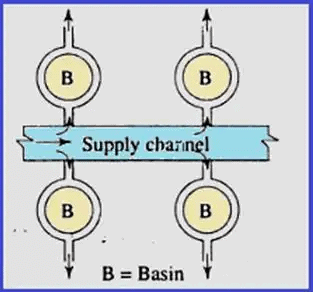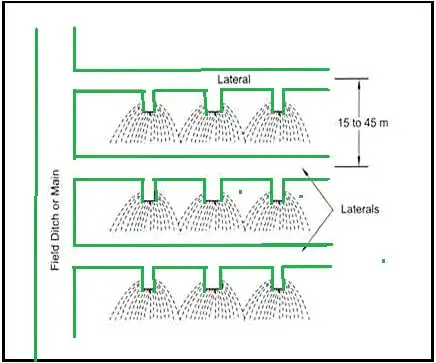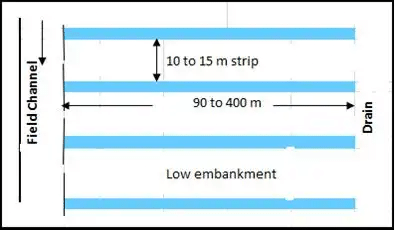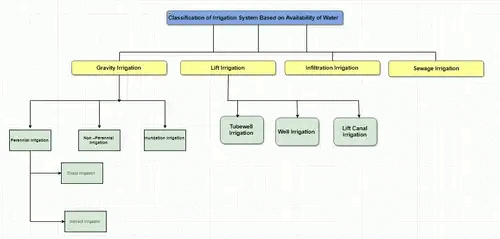Methods of Irrigation | Irrigation Engineering - Civil Engineering (CE) PDF Download
Types of Irrigation Systems
Major aim of irrigation systems is to help out in the growing of agricultural crops and vegetation by maintaining with the minimum amount of water required, maintenance of landscapes and re-vegetation of disturbed soils. Irrigation systems are also used for dust repression, removal of sewage, and in mining.
On the contrary, agriculture that relies only on direct rainfall is referred to as rain-fed or dry-land farming.
Techniques of Irrigation
In India, the irrigated area consists of about 36 percent of the net sown area. There are various techniques of irrigation practices in different parts of India. These methods of irrigation differ in how the water obtained from the source is distributed within the field. In general, the goal of irrigation is to supply the entire field homogeneously with water, so that each plant has the amount of water it needs, neither too much nor too little. Irrigation in India is done through wells, tanks, canals, perennial canal, and multi-purpose river valley projects. 1. Surface Irrigation
1. Surface Irrigation
In this technique, water flows and spreads over the surface of the land. Varied quantities of water are allowed on the fields at different times. Therefore, it is very difficult to understand the hydraulics of surface irrigation. However, suitable and efficient surface irrigation system can be espoused after taking into consideration different factors which are involved in the hydraulics of surface irrigation.
- Surface slope of the field
- Roughness of the field surface
- Depth of water to be applied
- Length of run and time required
- Size and shape of water-course
- Discharge of the water-course
- Field resistance to erosion
If the surface irrigation method is perfectly selected, it fulfils following requirements:
- It assists in storing required amount of water in the root-zone-depth.
- It reduces the wastage of irrigation water from the field in the form of run-off water.
- It reduces the soil erosion to minimum.
- It helps to apply a uniform application of water to the fields.
- Amount of manual labour required is less.
- It is suitable to the size of the field and at the same time it uses the minimum land for making ditches, furrows, strips, etc.
- It does not avert use of machinery for land preparation, cultivation, harvesting
Surface irrigation technique is broadly classified as
1. Basin irrigation: Basin irrigation is common practice of surface irrigation. If a field is level in all directions, is encompassed by a dyke to prevent runoff, and provides an undirected flow of water onto the field, it is herein called a basin. It may be furrowed or ridged, have raised beds for the benefit of certain crops, but as long as the inflow is undirected and uncontrolled into these field modifications, it remains a basin.
2. Furrow irrigation: In furrow irrigation technique, trenches or “furrows” are dug between crop rows in a field. Farmers flow water down the furrows (often using only gravity) and it seeps vertically and horizontally to refill the soil reservoir. Flow to each furrow is individually controlled. Furrow irrigation is suitable for row crops, tree crops and because water does not directly contact the plants, crops that would be damaged by direct inundation by water such as tomatoes, vegetables, potatoes and beans. It is one of the oldest system of irrigation. It is economical and low-tech making it particularly attractive in the developing world or places where mechanized spray irrigation is unavailable or impractical.
In different situations, different furrow methods are used (Surajbhan 1978). They are mainly of five types:
- Sloppy Furrow
- Levelled Furrow
- Contour Furrow
- Serial Furrow
- Corrugated Furrow
There are numerous advantages of Furrow technique of irrigation:
- Large areas can be irrigated at a time.
- It saves labour since once the furrow is filled, it is not necessary to give water a second time.
- It is a reasonably cheaper method.
- Plants get proper quantity of water by this system.
Major drawback of furrow system of irrigation is ensuring uniform dispersal of water over a given field. To tackle this problem, some farmers engage in field levelling to remove any small hills that would have been bypassed by the gravity flow of the water. Other problem with furrow irrigation is the increased potential for water loss due to runoff. Building retention ponds along the edges of fields can help capture this runoff, allowing it to be pumped back to the upslope side of the field for use in further irrigation cycles.
- Uncontrolled flooding: There are many cases where croplands are irrigated without regard to efficiency or consistency. These are usually situations where the value of the crop is very small or the field is used for grazing or recreation purposes. Small land holdings are generally not subject to the range of surface irrigation practices of the large industrial farming systems. The assessment methods can be applied if desired, but the design techniques are not generally applicable nor need they be since the irrigation practices tend to be minimally managed.
- Free flooding: This flooding system of irrigation is used from ancient times. Flooding method consists in applying the water by flooding the land of rather smooth and flat topography. In current irrigation practice, several flooding methods have been developed. In free flooding method, water is applied to the land from field ditches without any check or guidance to the flow. The land is divided into plots or kiaries of suitable size depending on porosity of soil. Water is spread over the field from watercourse. The irrigation operation begins at the higher area and proceeds towards the lower levels. The flow is stopped when the lower end of the field has received the desired depth of water. The field watercourse is properly spaced, the spacing depends on the topography, oil texture, depth of soil and size of stream.
 This technique is beneficial for newly established farms where making furrows is very expensive. This method is economical and can be effectively used where water supply is in plenty. This method is suitable for the fields with an irregular surface in which other techniques are difficult to apply.
This technique is beneficial for newly established farms where making furrows is very expensive. This method is economical and can be effectively used where water supply is in plenty. This method is suitable for the fields with an irregular surface in which other techniques are difficult to apply.
The major drawback of this method is that there is no perfect control over the flow of water to attain high efficiency. Sometimes the flow of water over the soil is too rapid to fulfil soil moisture deficiency. On the other hand, sometimes water is retained on the field for a very long time and consequently, the water is lost in infiltration or deep percolation.
3. Border Strip Method: In this technique of irrigation, a field is divided into number of strips. The width of strip varies from 10 to 15 metres and length varies from 90 m to 400 m. Strips are separated by low embankments or levees. The water is diverted from the field channel into the strips. The water flows gradually towards lower end, wetting the soil as it advances. The surface between two embankments should essentially be level. It assists in covering the entire width of the strip. There is a general surface slope from opening to the lower end. The surface slope from 2 to 4 m/1000 m is best suited. When the slope is steeper, special arrangement is made to prevent erosion of soil.
Classification Based on Availability of Water

1. Gravity Irrigation
Gravity or flow irrigation is the type of irrigation in which water is available at a higher level as to enable supply to the land by gravity flow. In flow irrigation water is supplied to the fields though the canals off taking from head works. Gravity flow irrigation is cheaper compared to lift irrigation. The gravity irrigation is further classified as under.
- Perennial Irrigation: In this system assured the supply of water throughout the crop period to irrigation requirement of the crops is made available to the command area through storage of water done at the dam or diversion of supply made by means of head works at the off take point of the canal. Perennial irrigation may be either direct or indirect, as follows:
(i) Direct irrigation: In direct irrigation system, water is directly diverted from the river into the canal by the construction of diversion weir or barrage across the river without attempting to store water. This method is practiced where the river has the adequate perennial supply to feed the canal system at the times of crops periods.
(ii) Indirect irrigation: It is also termed as storage irrigation. Here water is stored in reserved during monsoon period by the construction of a dam across the river for supply into the off taking canals. Evidently indirect irrigation is adopted where the river is non –perennial or flow in the river is inadequate during lean period. Storage irrigation has greater irrigation potential the direct irrigation but is costly due to the cost of construction of the dam. - Non –Perennial Irrigation: Also called restricted irrigation. Canal supply is generally made available in non-monsoon period from the storage in small dams as in Kandi areas which inadequate to feed all the year round, and/or canal water is not required during monsoon due adequate rainfall in the command area.
- Inundation Irrigation: Inundation irrigation is done by a canal taking off from a river in flood without any diversion work. It depends on the periodical rise in water level of the river and the supply is drawn through open cuts in the river bank or creeks which are called heads. Owing to changes in the river course the heads have often to be changed. A regulator is, however, provided at the canal about 5 km downstream from the off take, where the discharge passing below in the canal is controlled and the surplus supply is escaped back into the river. Inundation canals usually flow only during the summer months and bring in large quantity of silt beneficial to crops.
(i) Design of Inundation Canal: The bed level in the channel is kept low enough to draw about half the full supply discharge of the canal in low river, i.e., in the middle of April and again in October, and narrow enough to limit the excessive high floods to the minimum possible. Full supply level is fixed with due consideration to the steady water level in the river during about 1 ½ months, usually fair irrigation season. Beyond the head regulator, design considerations of unlined canals apply equally to the inundation canals. However, higher values of silt factor f and water surface slope are adopted than those allowed for canals off taking from permanent head works. Generally the slope ranges between 0.20 and 0.25 m/km. Manning’s, Chezy or Lac the design of inundation canal.
Advantages:
(i) Economical in cost being the simplest system of irrigation as permanent head works is not to be constructed,
(ii) Silty water carried by the canal has manorial value, and
Disadvantages:
(i) Highs maintenance cost, and
(ii) Seasonal irrigation.
2. Tank Irrigation
Tanks on local streams form a significant source of irrigation especially in the peninsula area in the States of Karnataka, Maharashtra and Tamil Nadu. Tank irrigation belongs to category of storage irrigation. Tanks are small sized reservoirs formed by small earthen embankments to store runoff for irrigation. The site is selected within a watershed protected by vegetation and containing minimum of cultivated land so as to ensure minimum rate of sedimentation which lowers its storage capacity. Adequate soil conservation measures are essentially adopted to ensured quantity and quality of water inflow into the tank.
The essential components of irrigation that are tank embankment, surplus or escape weir, and outlet sluice. A suitable breaching section also sometimes provided to ensure that the tank embankment is not overtopped in the event excessive discharge from the catchment. The breaching section is a low level embankment of certain length designed to have a localized breach to escape excessive inflow.
3. Lift Irrigation
In lift irrigation water is lifted from a river or a canal to the bank to irrigate the land which are not commanded by gravity flow. Lift irrigation is being increasingly practiced in India. Every State such areas exist where irrigation can be extended only by lift canals. Lift irrigation also includes tube well irrigation but the latter is not feasible in areas where scarcity of water exists, climate is dry and groundwater is low, i.e., groundwater is in insufficient quantity and unsuitable quality. Lift canal then constitutes the only means of extension of irrigation to sound perched lands. A lift canal can cater for much larger areas than a tube well and is suitable when supplies either from a river or a canal are available for lifting to higher elevation.
Lift area is defined as the area the level of which is too high to permit irrigation by gravity flow from the source, but which can be irrigated by lifting water to the necessary level by means of pump Gross lift area is the portion of gross irrigable area which can be irrigated only by pumping.
In lift Irrigation mechanical devices like pumps, or electric motors and pumps are required to be installed for lifting water. Electrical pumps are generally provided for lifting water. Diesel pumping sets are also installed as standby.
- Lift Irrigation vs. Gravity Irrigation:
(i) Lift irrigation
(a) Costly means of irrigation
(b) Less manorial silt in water
(c) Working dependent on the operation of machinery
(d) Higher water rates.
(e) Lift irrigation is a complex system and by and large costly.
(ii) Gravity flow irrigation
(a) Cheapest means of irrigation
(b) Silt in water has manorial value
(c) Lifting equipment is not involved
(d) Lowest water rates
(e) Simple and economical system of irrigation.
4. Well Irrigation
- Groundwater: Groundwater is generally a more dependable source of irrigation than surface water and is free from seeds and plant organisms. The first cost of installation is, however, high. The best water bearing stratum or aquifer is coarse gravel free from sand but such formation are rare to find. An aquifer is a saturated formation which creates the ground water reservoir and yields sufficient quantity of water to wells or springs. These are made of unconsolidated formations like sand, gravel, fractured rocks.
- Subsurface Irrigation: It is termed as subsurface irrigation because in this type of irrigation, water does not we the soil surface. The underground water nourishes the plant roots by capillarity. It may be divided into the following two types:
Natural sub-irrigation; and Artificial sub-irrigation.
(i) Natural sub-irrigation: leakage water from channels, etc., goes underground, and during passage through the subsoil, it may irrigate crops, sown on lower lands, by capillarity. Sometimes, leakage causes the water –table to rise up, which helps in irrigation of crops by capillarity. When underground irrigation is achieved, simply by natural processes, without any additional extra efforts, it is called natural sub-irrigation.
(ii) Artificial sub-irrigation: when a system of open jointed drains is artificially laid below the soil, so as to supply water to the crops by capillarity, then it is known as artificial sub-irrigation. It is a very costly process and hence, adopted in India on a very small scale. It may be recommended only in some special cases with favourable soil conditions and for cash crops of very high return. Sometimes, irrigation water may be intentionally collected in some ditches near the fields, the percolation water may then come up to the roots through capillarity.
5. Sprinkler Systems
In the sprinkler irrigation network, we have the mains and the subdomains, through which water under pressure is made to flow. Revolving sprinkler heads are then usually mounted on rising pipes attached to the laterals. The water jet comes out through the revolving sprinkler heads, with force. When sprinkler heads are not provided, perforations are made in the pipes, and they are provided with nozzles, through which water jets out and falls on the ground. Generally, such a perforated pipe system operates at low heads; whereas, the revolving heads sprinklers operate on high as well as low heads, depending upon the type of rotary head used.
- The advantage of sprinkler irrigation are enumerated below:
(i) Seepage losses, which occur in earthen channels of surface irrigation methods, are completely eliminated. Moreover, only the optimum quantity of water is used in this method.
(ii) Land levelling is not required, and thus avoiding removal top fertile soil, as happens in other surface irrigation methods.
(iii) No cultivation area is lost for making ditches, as happens in surface irrigation methods. It, thus, results in increasing about 16% of the cropped area.
(iv) In the sprinkler system, the water is to be applied at a rate lesser than the infiltration capacity of the soil, and thus avoiding surface run, and its bad effects, such as loss of water, washing of topsoil, etc.
(v) Fertilizers can be uniformly applied because they are mixed with irrigation water itself.
(vi) This method leaches down salts and prevents waterlogging or salinity.
(vii) It is less labour oriented, and hence useful where labour is costly and scarce.
(viii) Upto 80% efficiency can be achieved, i.e. upto 80% of applied water can be stored in the root zone of plants/. - Limitations of sprinkler irrigation nare also enumerated below:
(i) High winds may distort sprinkler pattern, causing non-uniform spreading of water on the crops.
(ii) In areas of high temperature and high wind velocity, considerable evaporation losses of water may take place.
(iii) They are not suited to crops requiring frequent and larger depths of irrigation, such as paddy.
(iv) The initial cost of the system is very high, and the system requires a high technical skill.
(v) Only sand and silt free water can be used, as otherwise pump impellers lifting such waters will get damaged.
(vi) It requires a larger electrical power.
(vii) Heavy soil with poor intake cannot be irrigated efficiently.
(viii) Constant water supply is needed for commercial use of equipment.
6. Drip irrigation Method
Drip irrigation, also called trickle irrigation, is the latest field irrigation technique and is meant for adoption at places where there exists acute scarcity of irrigation water and other salt problems. In this method, water is slowly and directly applied to the root zone of the plants, thereby minimizing the losses by evaporation and percolation.
This system involves laying a system of the head, mains, sub mains, laterals, and drop nozzles. Water oozes out of these small drip nozzles uniformly and at a very small rate, directly into the plant roots area.
The head consists of a pump to lift water, so as to produce the desired pressure of about 2.5 atmospheres, for ensuring proper flow of water through the system. The lifted irrigation water is passed through a fertilizer tank, so as to mix the fertilizer directly in the irrigation water, and then through a filter, so as to remove the suspended particles from the water, to avoid clogging of drip nozzles.
|
7 videos|49 docs|31 tests
|
FAQs on Methods of Irrigation - Irrigation Engineering - Civil Engineering (CE)
| 1. What are the different methods of irrigation in civil engineering? |  |
| 2. What is surface irrigation? |  |
| 3. How does sprinkler irrigation work? |  |
| 4. What is drip irrigation? |  |
| 5. What is center pivot irrigation? |  |





















